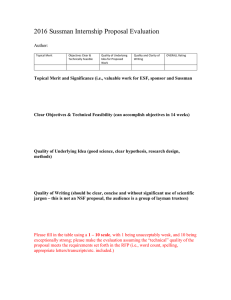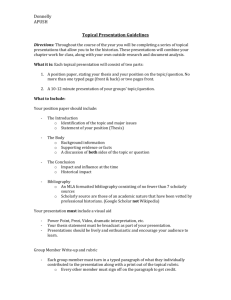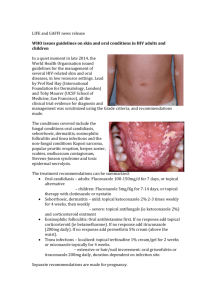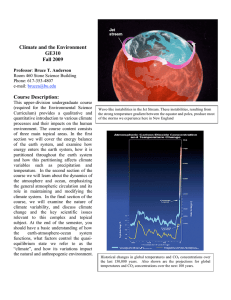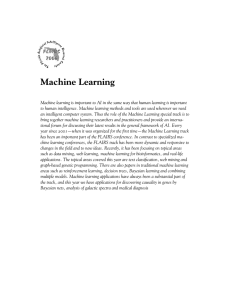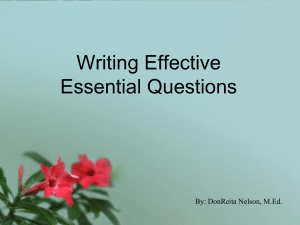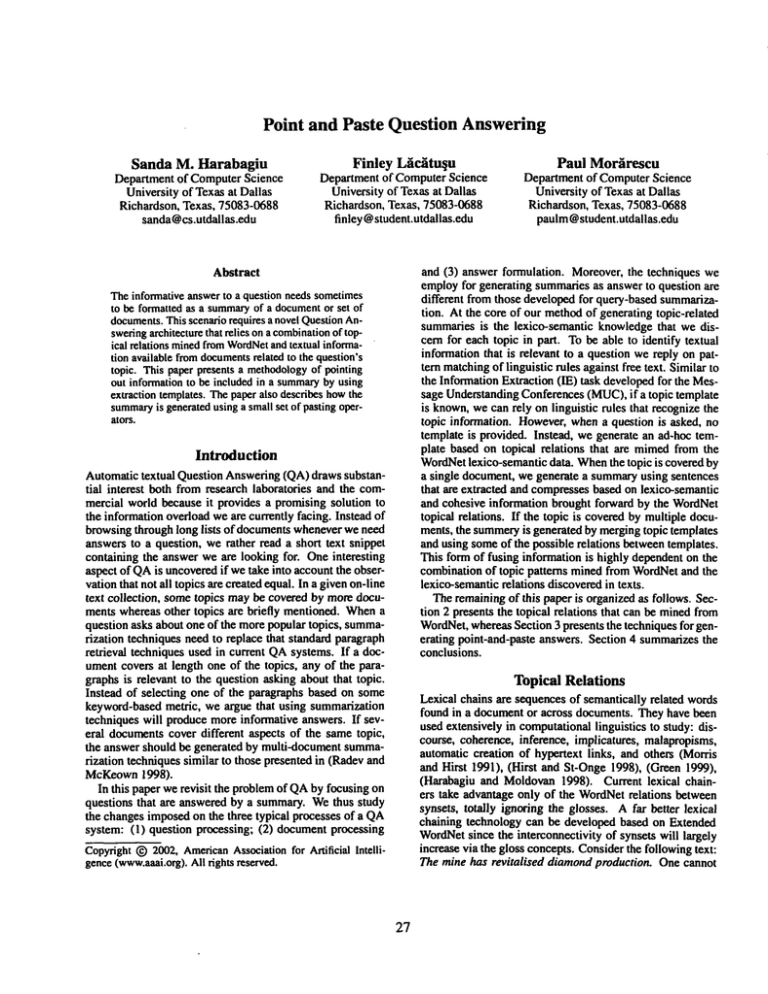
Point and Paste Question Answering
Sanda M. Harabagiu
Department of ComputerScience
University of Texasat Dallas
Richardson, Texas, 75083-0688
sanda@cs.utdallas.edu
Finley L~c~tu~u
Department of ComputerScience
University of Texasat Dallas
Richardson, Texas, 75083-0688
finley @student.utdallas.edu
Abstract
The informativeanswerto a question needssometimes
to be formattedas a summary
of a documentor set of
documents.
This scenariorequires a novelQuestionAnsweringarchitecturethat relies on a combination
of topical relations minedfromWordNet
and textual information availablefromdocuments
related to the question’s
topic. This paper presents a methodology
of pointing
out informationto be included in a summary
by using
extractiontemplates.Thepaperalso describeshowthe
summary
is generatedusing a small set of pastingoperators.
Introduction
Automatictextual Question Answering(QA)draws substantial interest both from research laboratories and the commercial world because it provides a promising solution to
the informationoverload we are currently facing. Instead of
browsingthrough long lists of documentswheneverwe need
answersto a question, we rather read a short text snippet
containing the answer we are looking for. Oneinteresting
aspect of QAis uncoveredif we take into accountthe observation that not all topics are createdequal. In a givenon-line
text collection, sometopics maybe covered by more documents whereas other topics are briefly mentioned. Whena
question asks about one of the more popular topics, summarization techniques need to replace that standard paragraph
retrieval techniques used in current QAsystems. If a documentcovers at length one of the topics, any of the paragraphs is relevant to the question asking about that topic.
Instead of selecting one of the paragraphs based on some
keyword-basedmetric, we argue that using summarization
techniques will produce more informative answers. If several documentscover different aspects of the same topic,
the answer should be generated by multi-document summarization techniques similar to those presented in (Radevand
McKeown1998).
In this paper we revisit the problemof QAby focusing on
questions that are answeredby a summary.Wethus study
the changes imposedon the three typical processes of a QA
system: (l) question processing; (2) documentprocessing
Copyright~) 2002, American
Associationfor Artificial Intelligence(www.aaai.org).
All rights reserved.
27
Paul Mor,~rescu
Department of ComputerScience
University of Texasat Dallas
Richardson, Texas, 75083-0688
pauim@student.utdallas.edu
and (3) answer formulation. Moreover, the techniques
employfor generating summariesas answer to question are
different from those developed for query-based summarization. At the core of our methodof generating topic-related
summariesis the lexico-semantic knowledgethat we discem for each topic in part. To be able to identify textual
informationthat is relevant to a question we reply on pattern matchingof linguistic rules against free text. Similar to
the InformationExtraction (IE) task developedfor the Message UnderstandingConferences(MUC),if a topic template
is known,we can rely on linguistic rules that recognize the
topic information. However,whena question is asked, no
template is provided. Instead, we generate an ad-hoc template based on topical relations that are mimedfrom the
WordNetlexico-semantie data. Whenthe topic is covered by
a single document,we generate a summaryusing sentences
that are extracted and compressesbased on lexico-semantic
and cohesive information brought forward by the WordNet
topical relations. If the topic is coveredby multiple documents, the summery
is generated by mergingtopic templates
and using someof the possible relations betweentemplates.
This form of fusing information is highly dependenton the
combinationof topic patterns minedfrom WordNetand the
lexico-semanticrelations discoveredin texts.
The remainingof this paper is organized as follows. Section 2 presents the topical relations that can be minedfrom
WordNet,whereasSection 3 presents the techniques for generating point-and-paste answers. Section 4 summarizesthe
conclusions.
Topical Relations
Lexical chains are sequences of semantically related words
found in a documentor across documents. They have been
used extensively in computationallinguistics to study: discourse, coherence, inference, implicatures, malapropisms,
automatic creation of hypertext links, and others (Morris
and Hirst 1991), (Hirst and St-Onge 1998), (Green 1999),
(Harabagiu and Moldovan1998). Current lexical chainers take advantage only of the WordNetrelations between
synsets, totally ignoring the glosses. A far better lexical
chaining technology can be developed based on Extended
WordNet
since the interconnectivity of synsets will largely
increase via the gloss concepts. Considerthe followingtext:
The mine has revitalised diamondproduction. One cannot
{SHi
}: (CHi
J)
ISml: (Cm’i)
.------’¢" {Sjl: (Cj.
k)
l
~
/
{Si} : (CidJ
/\
- .I )
{Shi}
: (Ch;
Figure 1: topical" relations are extracted’ffbmseveral sources
Morphological
Gloss
relation
Synset
(the soundof laughing:v#1)
noun - verb
laughter:n#1
immediately:r#3 (beating an immediate:a#2relation)
adverb- adjective
(take out insurance:n#3for)
verb - noun
insure:v#4
(..characteristic of or befitting a parent:n#1) adjective - noun
parental:adj#2
Table 1: Examplesof newmorphologicalrelations revealed by the topical relations
explain the cohesion,and the intention of this simple text by
using only the existing lexico-semantic relations like those
encoded in WordNet(Fellbaum 1998). Typical relations
encoded in lexico-semantic knowledgebases like WordNet
comprise hypernymy, or IS-A relations, meronymyor PARTOFrelations, entaibnent or causation relations. Noneof
these relations can be established betweenany of the words
from the abovetext. However,it is obvious that this short
text is both cohesive, as wordshave morethan syntactic relations joining them, and coherent,as it is logical. Relations
that account for the cohesionof the abovetext can be mined
from WordNet’sglosses that define the encoded concepts.
In WordNeteach concept is represented through a synonym
set of words sharing the same part-of-speech. Such synonymsets are knownarts synsets. The words used to define the synset {mine} are related to the wordsused to define the synset {diamond}. Furthermore, these two synsets
are related to other synsets containing wordssuch as ring,
bracelet or gemand precious. Similarly, production, market
and mine are related to the nameof big diamondconcerns
like De Beers. All these relations convergetowardthe topic
of "diamondmarket", bringing forward all the various concepts that define the topic. This is whywe call themtopical
relations.
A good source for topical relations is WordNet,namely
the glosses defining each synset. Topical relations are pointers that link a synset to other related synsets that mayoccur in a discourse. Topic changes from a discourse to another, and the sameconcept maybe used in different contexts. Whenthe context changes, the concepts used change.
For example, the diamondmarket can be discussed from a
financial, or geological, or gem-jewelrypoint of view. In
each case, the concepts used wouldbe quite different. This
pluralism of topics for the sameconcept creates confusion
and difficulty in identifying related concepts.
Thesourcesfor the topical relations are illustrated in Figure
1.
1. The first place wherewe look is the gloss of each concept. Since the gloss concepts are used to define a synset,
28
they clearly are related to that synset. Fromthe gloss definition we extract all the nouns, verbs, adjectives and adverbs,
less someidiomatic expressions and general concepts that
are not specific to that synset. For example,the gloss of the
concept diamondis (a transparent piece of diamondthat has
beencut and polished and is valued as a precious gent)
2. Eachconcept Ci,j in the gloss of synset Si points to a
synset Sj that has its owngloss definition. The concepts
C’./,~ mayalso be relevant to the original synset Si. Although
this mechanism
can be extendedfurther, we will stop at this
level. For the case of the gloss of diamond,we shall have
pointers to the glosses of gem,cut, polish, valued and precious.
3. A third source is the hypernymSHi and its gloss with
concepts CHi,I. For examplethe synset {jewelry, jewelry.}
is one of the hypernymsof diamond,having its owngloss.
Other relations such as causation, entailment and meronymy
are treated in the samewayas the hypernymy.
4. Yet another source consists of the glosses in whichsynset
Si is used. Thosesynsets, denoted in the figure with Smare
likely to be related to Si since this is part of their definitions.
This schemeof constructing topical relations connects a
synset to manyother related synsets, somefrom the same
part of speechhierarchy, but manyfromother part of speech
hierarchies. The increased connectivity betweenhierarchies
is an important addition to WordNet.Moreover,the creation
of topical relations is a partial solution for the derivational
morphologyproblem that is quite severe in WordNet.In
Table I we showa few examplesof morphologicallyrelated
wordsthat appear in synsets and their glosses whichwill be
linked by the newtopical relations.
Paths betweensynsets via topical relations
Figure 2 showsfive synsets St to $5, each with its topical
relation list representedas a vertical line. In the list of synset
Si there are relations rij pointing to Sj.
It is possible to establish some connections between
synsets via topical relations. Wepropose to develop software that automatically provides connecting paths between
any two synsets Si and Sj up to a certain distance as shown
!
:
five synsets
paths that can be es blished betweenthe i lynsets
in Table 2. The meaningof these paths is that the concepts
along a path have in common
that they mayoccur in a discourse, thus are topically related. These paths should not
be confused with semantic distance or semantic similarity
paths that can also be established on knowledgebases by
using different techniques.
Explanation: polish:v#1 is part of the definition of synset
diamond:n#1,
thus it is on its topical relations list.
Example 2: Is there any topical relation between ring
and diamond?
Answer: there is a W-path: diamond:n#1 ~ gem:n#1
ring:n#1
Explanation: gem:n#1is found in the definition of diamond:n#1and is also found in the definition of ring:n#1.
I Name
I Path
I
V- path
W- path
Si -Sk-Sj
VW- path s~ -s~-s~-s,
WW
- path &-s~-&-sm-sj
Table2: Typesof topically related paths
Example 3: Is there a topical connection between diamondand gold?.
Answer:there is a VW-path:diamond:n#1--* gem:n#1*-ring:n#1--+ gold:n#1
Explanation: diamond:n#1has gem:n#1in its definition,
which in turn is in the definition of r/rig:n#1 which is
defined by gold:n#1.
The nameof the paths was inspired by their shape in Figure 2. The V path links directly Si and Sj either via a rij or
rj,i, namelyeither Si has Sj in its list of topical relations or
vice versa. The Wpath allows one other intermediate synset
between Si and Sj. Similarly, the VWpath allows two intermediate synsets and the WW
path allows three intermediate synsets. Welimit the length of the path to five synsets.
For each type of path, there are several possible connections
depending on the direction of the connection between two
adjacent synsets (i.e. via ri,j or rj,D. Theseconnections
are easily established with knownsearch methods. When
searching for all topical relations of a given concept, wemay
assumethat we try to establish whetherthere are topical relations betweenthat concept and any other concept encoded
in WordNet.To speed-up the search, we rely on hash tables
of all possible paths betweenany sysnet and any other possible sysntet fromWordNet.In this way,at processing time,
retrieving all conceptsthat characterize a topic is a fast and
robust process.
Examples
Supposeone wants to find out whether or not there are any
topical relations between two words. The system will try
to establish topical paths betweenany combinationof the
senses of the two words. Here are someexamples:
Example4: Is there a possible topical relation between
diamond and mine?
Answer:there is a WW-path:diamond:n#1t-- gem:n#1--r
ring:n#4 --* gold:ngl ~ mine:n#1
Explanation: gold:n#1 is in the definition of mine:n#1,and
the rest is as before.
Answering questions with summaries
There are questions whoseanswer cannot be directly mined
from large text collections because the informationthey request is spread across full documentsor across several documents. Instead of returning all those documents,the answer
should summarizethe textual information contained in the
texts. To generate summariesas response to a question, the
architecture of the typical QAsystemneeds to be modified.
Figure 3 illustrates the newQAarchitecture capable of answeringquestion of the type "Whatis the situation with the
diamond market?".
Instead of capturingthe semanticsof the questionby classifying against the question stem (e.g. what, whoor how),
the question processingmoduleidentifies the topic indicated
by the question. Topicidentification is performedby first ex-
Example 1: Is there any topical relation between diamondand polish?
Answer:there is a V-path: diamond:n#1
--+ polish:v#1 t
part-of-speechof the synset and by the sense of that word.For
parts-of-speech,wedenotenounsas n, verbs as v, adjectivesas a
and adverbsas r, followingthe samenotationas in WordNet.
tWedenote a synset by one of its elements,followedby the
29
Input article set
Input article
~
GISTexter
Single-Document
Summarizer
T
I SentenceExtracti°n ~
_
~
i
~ s~fo: Document
I,
.---...
,"" Comusot
"",~
: human-written:9
¯ . abstracts ."
Sum~
Figure 4: Architecture of GISTEXTER
Question
Processing
Multi-Document
Summary Summarization
System
Figure 3: Architecture of QAsystems that answer question
with a summary.
tracting the context wordsfrom the question and then mining their associated topical relations from WordNet.Topical
paths that display a high degree of redundancyare grouped
as separate topics and are used to process the documents.Instead of performingparagraphretrieval as it is donein current fact-based QAsystem, documentprocessing involves
a topical categorization of the collection and returns either
single documentsthat are characteristic of the topic or set
of such documents.Finally, a summarizationsystem generates the answerto the question in the form of a summaryof
predefinedsize or compressionrate.
For the purpose of summarization,we have trained a summarization system on the corpus of documentsand correspondingabstracts written by four different humanassessors
for the DUC-2001
evaluations. Our system, called GiSTEX-
3O
TERgeneratesboth single-documentand multi-document
summaries.
Twoassumptions
stay at the core of our techniques:(1)
whengenerating the summary
of a single document,we
shouldextract the sameinformationa human
wouldconsider
whenwriting an abstract of the samedocument;(2) when
generating a multi-documentsummary,weshould capture
the textual informationsharedacrossthe document
set. To
this end, for the multi-document
summaries
wehaveapplied
the CICERO
InformationExtraction (IE) systemto generate
extraction templates for someof the topics that werealready
encoded in the multi-domain knowledgeof CICERO
2.
For the topics that werenot coveredby CICEROwehad a
back-upsolution of gisting informationby combining
cohesion and coherence
indicators for sentenceextraction. By
definition, gisting is an activity in whichthe information
taken into accountis less than the full informationcontent
available, as reported in (Resnik 1997). In our backupsolution, getting the gist of the summary
information is performed by assumingthat the more cohesive the gisted information is, the moreessential it is to the multi-document
summary.In addition coherence cue phrases were considered for information extraction. At the core of getting the
gist of the summarystay topical relations extracted from
WordNet.
The architecture of G ISTEXTER
is shownin Figure 4. Input to the systemis either a single document
or a set of documents. Whena summaryfor a single documentis sought,
in the first stage key sentences are extracted, as in mostof
the current summarizers.A sentence extraction function is
2CICEROis an ARDA-sponsored
on-goingproject that studies
the effects of incorporatingworldknowledge
into IE systems.CICERO
is being developedat LanguageComputerCorporation.
learned, based on features of the single-documentdecwnposition that analyzes the features of human-writtenabstracts
for single documents.Tofurther filter out un-necessaryinformation, the extracted sentences are then compressed.In
the last stage a summary
reduction is performed,to trim the
whole summaryto the length of 100 words.
If multi-documentsummariesare sought, two situations
arise:
Case 1: the topic of the documentset has been encodedin
the multi-domain knowledgeof CICERO,therefore the IE
systemextracts templates filled with informationrelevant to
the topic of the documentset. To fill extraction templates
CICEROperforms a sequence of operations, implemented
as cascaded finite-state automata. The texts are tokenized
and the namedentities are semantically disambiguated,then
phrasal parses are generated and combinedinto noun and
verb groupstypical to a given topic of interest. Coreference
betweenentities is resolved and the mentionsof the events
of interest are identified. Beforemerginginformationreferring to the sameevent, coreference betweenentities related
to the sameevent is resolved. The textual information that
fills the templates is used for content planning and generation of the multi-documentsummary.
Case 2: the topic is new and unknown.In this case the
human-writtenabstracts are decomposedto analyze the cohesive and coherence cues that determine the extraction of
textual information for the multi-document summary.For
the analysis of the cohesive information, we use the topical relations mined from WordNetas well as the semantic
classes of the namedentities provided by CICERO.
The coherence information is indicated by cue phrases such as because, therefore or but but also by very dense topical relations betweenthe wordsof the text fragment.
2. Application of SummaryOperators - after commonfeatures of multiple templatesare identified and the distinct
features are markedup, summaryoperators are applied
to link information from different templates. Often this
results into the synthesis of newinformation. For example, a generalization maybe formed from two independent facts. Alternatively, since almostall templateshavea
TIME and a LOCATIONslot, contrasts can be highlighted
by showinghowevents changes along time or across different locations. The operators we encoded in GISTEXTERare listed in Table3 and weredefined and first introduced in (Radev and McKeown
1998).
3. Orderingof Templatesatut Linguistic Generation- whenever an operator is applied, a newtemplate is generated
by merginginformation from the argumentsof the operator. All such resulting templatesare scored highly then the
extracted templates. Moreover,dependingon the slots the
operators merged,the scores havedifferent values. At the
end, information from templates with higher importance
appear with priority in the resulting summary.Weuse the
topical relations to realize only those sentence fragments
that are identified by extraction patterns.
Name
Changeof Perspective
Definition
Thesameevent described
differently
Contradiction
Conflictinginformationaboutthe
sameevent
Addition
Additionalinformationabout an event
is broughtforward
Refinement
Moregeneral informationabout an
eventis refinedlater
Superset/Generalization Combinetwo incomplete
templates
Trend
Severaltemplateshavecommon
fillers
for the sameslot
Single-Document Summarization
To generate lO0-wordsummariesfrom single textual documents, we have implementeda sequence of three operations:
Table 3: SummaryOperators.
1. SentenceExtraction- identifying sentences in the original
documentthat contain information essential for the summary;
Whenthe topic is not encoded in CICERO, we need to
further implementtwoadditional steps:
1. Automatic Generation of the Extraction Template - in
whichtopical relations are used to find redundantinformation,and thus use it as slots of the template;
2. AutomaticAcquisition of Extraction Patterns - in which
linguistic rules capable of identifying informationrelevant to the topic in text and to extract it by filling the
slots of the template. Usually, such textual information
represents only about 10%of a document.
For generating extraction templates we collect all the sentences that contain at least twoconceptsthat are related to
the topic. Wethen categorize semanticallyall these concepts
and select the most common
classes observed in the corpus.
To these classes we add NamedEntity classes (e.g. PERSON,
LOCATION,DATEand ORGANIZATION).
We consider the
eachof these twotypes of classes as the slots of the template.
Whenthe extraction template is ready, extraction patterns
are learned by applying the bootstrapping techniques de-
2. Sentence Compression- reducing the extracted sentences
by filtering out all non-importantinformation while preserving the grammaticalquality;
3. SummaryReduction - trimming the resulting summaryto
the required 100 word/documentlimit.
The sentence extraction is based on the topical relations,
whereas sentence compression combines the topical relations with syntactic dependencies. The summaryreduction
simply retains only the first I00 wordsfrom the summary.
Multi-Document Summarization
The generation of multi-documentsummariesis a two-tired
process. Whenthe topic is one of the 20 topics encodedin
CICERO, we generate the summaryas a sequence of three
operations:
1. TemplateExtraction - filling relevant information in the
slots of predefinedtemplates correspondingto each topic;
31
scribed in (Riloff and Jones 1999). If there is any document from which we cannot extract at least a template, we
eliminate the slot corresponding to the least popular semantic class and continue until we have at least on template per
document.
The extraction techniques have the role of pointing where
the information that should be included in the summaryexists. But we also need to paste this information in a coherent
and cohesive summary. This form of generation was first
introduced in (.ling and McKeown2000). Instead of using
knowledge represented in the form of templates alone, cutand-paste operators provide a way of generating summaries
by transforming sentences selected from the original documents because they were matched by extraction patterns.
The cut-and-paste operators are listed in Table 4.
Name
Sentence reduction
Sentence combination
Paraphrasing
Generalization/Specification
Reordering
S. Harabagiu. M. Pa~ca and S. Maiorano. Experiments with
Open-DomainTextual Question Answering. In Proceedings of
the 18th International Conference on ComputationalLinguistics
(COLING-2000),August 2000, Saarhruken Germany,pages 292298.
S. Harabagiu, D. Moidovan,M. Pa~ca, R. Mihalcea, M. Surdeanu,
R. Bunescu,R. Girju, V. Rusand P. Mor~rescu.Therole of lexicosemantic feedback in open-domaintextual question-answering. In
Proceedings of the 39th Annual Meeting of the Association for
ComputationalLinguistics (ACL-2001),Toulouse, France, 2001,
pages 274-28 I.
G. Hirst and D. St-Onge. Lexical Chains as Representations
of Context for the Detection and Correction of Malapropisms.
WordNet-AnElectronic Lexical Database. The MIT Press,
C. Fellbaumeditor, pp 305-332, 1998.
E. Hovy, L. Gerber, U. Hermjakob,C-Y. Lin, D. Ravichandran.
Towardsemantic-based answer pinpointing. In Proceedings of
the HumanLanguage Technology Conference (HLT-2001), San
Diego, California, 2001.
H. Jing and K. McKeown.
Cut and Paste Text Summarization. In
Proceedingsof the First Meeting of the North AmericanChapter
of the Association of ComputationalLinguistics (NAACL-2000),
pages 178-185, 2000.
W. Lehnert. The Process of Question Answering: a computer
simulation of cognition. LawrenceErlbaum,! 978.
G.A. Miller. WordNet:a lexical database. Communicationsof
theACM,38(I I):39--41, 1995.
J. Morris and G. Hirst. Lexical CohesionComputedby Thesaural
Relations as an Indicator of the Structure of Text. In Computational Linguistics, Vol.! 7, no 1, pp. 21-48,! 99 !.
D.R. Radev and K.R. McKeown.Generating natural language
summariesfrom multiple on-line sources. Computational Linguistics, 24(3):469-500, 1998.
P. Resnik. Evaluating Multilingual Gisting of WebPages. AAA!
Spring Symposiumon Natural LanguageProcessing for the World
Wide Web, 1997.
E. Riloff and R. Jones. Learning Dictionaries for Information
Extraction by Multi-LevelBootstrapping. Proceedingsof the Sixteenth National Conferenceon Artificial Intelligence (AAAI-99),
pages 474-479, 1999.
Definition
Removeextraneous phrases
from sentence
Mergetext from
several sentences
Replacephrases with their
paraphrases
Replace phrases with more
general/specific phrases
Changethe order of sentences
Table 4: Cut-and-Paste Operators.
Conclusions
In this paper we described a new paradigm for answering
natural language questions. Whenevera question relates to
a topic that is discusses extensively in a document or set
of documents, the answer produced is a summary of those
texts. The generation of the summaryrelies on mining topical relations from the WordNetknowledge base. In this way,
answers are mined both from the texts and the lexical knowledge base encode in WordNet.
Acknowledgments: This research
ARDA’s AQUAINTprogram.
was partly
funded by
References
Christiane Fellbaum(Editor). WordNet- AnElectronic Lexical
Database. MITPress, 1998.
S.J. Green. Building Hypertext Links by ComputingSemantic
Similarity. IEEETransactions on Knowledgeand Data Engineering, pp 713-730,Sept/Oct1999.
S.M. Harabagiu and D.L Moldovan.KnowledgeProcessing on an
Extended WordNet. W0rdNet-AnElectronic Lexical Database.
The MITPress,C. Fellbaumeditor, pp 379-406, 1998.
S. Harabagiu, G.A. Miller and D. Moldovan.WordNet2 - A Morphologically and Semantically EnhancedResource. In Proceedings of SIGLEX-99,June 1999, Univ. of Maryland,pages I-8.
S. Harabagiuand S. Maiorano.Finding answers in large collections of texts: Paragraphindexing + abductive inference. In AAAI
Fall Symposiumon Question Answering Systems, pages 63-71,
November1999.
32


